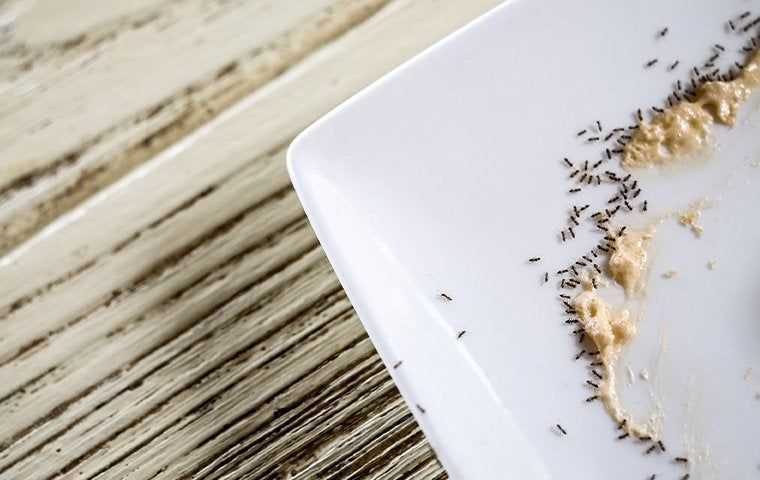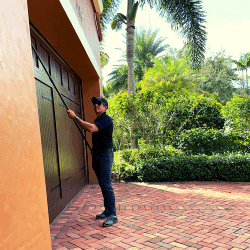Ant Control
Get a Free Quote
For Faster Service
Give Us A Call
Top Rated Pest Control in Broward County & Palm Beach County
On this page, you will learn how pest management professionals eliminate ants and how we customize each treatment to the specific pest species known to infest homes in South Florida. We will also touch heavily on the active ingredients in our treatments and how each class of chemical kills ants.
By reading this page, you’ll also get some basic knowledge of ant diets. This knowledge is important because it helps us choose the right bait during a baiting program. You will also learn about their nesting grounds, why ants move indoors, and some things homeowners can do to help prevent ants from infesting a home. The control methods we utilize incorporate the most innovative technologies in the industry in terms of products, tools, protocols, and application techniques. These treatments are very powerful and will get rid of the ants for good.
At GOTBUGSIKILL, we are the biggest bug nerds, so we created a Pest Library. Here you will learn more fascinating things about the most common household pests in South Florida. We have a dedicated page to Ants where you will learn about their life cycle and how they communicate with each other.
Why Do I Have Ants In My Home?
 Every insect needs three things to survive: food, water, and shelter. When it comes to ants, your home provides the perfect harborage for this pest.
Every insect needs three things to survive: food, water, and shelter. When it comes to ants, your home provides the perfect harborage for this pest.
The kitchen is often the number one place where you will find ants. Besides water, ants need three macronutrients. Like humans, ants also need carbohydrates, proteins, and lipids to survive, each of which serves an important biological function.
- Carbohydrates: sugar, honeydew, plant nectar
- Proteins: meats, seeds
- Lipids: fats, oils, grease
Foraging ants bring proteins to the queen or queens of their colonies for egg production, while lipids and carbohydrates are used as an energy source to expand the colony and promote larval growth.
Ants need shelter so the queen can safely lay eggs and raise the brood (larvae and pupae). Ant mounds absorb moisture while protecting them from predators and the elements. The best shelter for ants is small cavities or voids inside or near your home. Indoor wall voids and cavities between the cabinets are ideal spots for ants to take up residence.
If you have any of the above sources of food or shelter in your home, don’t be surprised if ants invade.
How Do Ants Find Food?
Ants are extraordinary insects capable of creating colonies with millions of members. One of the ways ants organize, communicate, and solve problems is by chemical signals and chemical receptors that process this information.
Ants have chemical receptors on their antennae. When foragers scout for food, they rely on these organs. Foraging worker ants move in every direction until they bump into something interesting. Depending on the needs of the colony, the foragers will only bring foods that have one of these macronutrients at a time. When the ants rub their antennae against the food, they can decipher if the food meets the immediate nutritional needs of the colony.
If the colony requires more carbohydrates, the scout will not stop looking until they find something sweet, such as syrup, honey, or the candy jar. Once it has located a food source, the foraging ant will walk back to the colony, leaving a pheromone scent trail. Other ants will pick up on this scent through the same chemical receptors and by stroking their antennae as they bump into one another. As the pheromone scent intensifies, ants will begin to follow the trial more heavily. Once the food is gone or the ants lose interest, the pheromone scent dissipates, and the trailing activity ends.
Ants use pheromone scents in a number of different ways. Beyond the search for food, when ants are killed or feel threatened, they release “danger” pheromones to alert nearby ants.
Why Are Ants Difficult To Control?
Ants are social insects that live in colonies. The colonies are divided into three castes: workers, males, and queens. Some of the most difficult ants to control have multiple queens within a single colony, such as pharaoh ants, bigheaded ants, crazy ants, and ghost ants.
The workers are the ants we usually see foraging for food. Only a small percentage of the members forage. Most of the individuals perform critical tasks such as excavating, cleaning, caring for the brood (eggs, larvae, and pupae), and tending the queen.
For most species, only 10% of the colony forages for food, and this is the primary reason why ants are tricky to eliminate. If we only kill the foraging ants and not all the ants inside the colony, the queen will quickly replace those workers, and the ants will simply return in no time.
What Is The Best Way To Get Rid Of Ants?
The best way to get rid of ants in your South Florida home is with a multipronged approach. This involves inspection & identification, customer education, and chemical treatment.
Inspection & Ant Identification
The first step to any ant control program is to identify the species infesting your home. Each species has unique behavioral traits and nutritional needs, so the treatments are targeted to the specific type of ant. After proper identification, your pest management professional will develop a customized treatment plan.
If you want to inspect for ants yourself, use a flashlight to look along the edges of countertops, cabinets, and baseboards, as well as under the sink and in between appliances like the refrigerator, stove, and dishwasher. Often you can follow the ant trail to the main nest located outdoors.
When inspecting the exterior, look along the foundation and windowsills. Look for any vegetation touching the home that ants could use as a bridge. Ants will also use utility lines to travel between properties; white-footed ants are notorious for doing this. Inspect any areas that can hold moisture where newly inseminated queens will want to establish a new colony. Look under rocks, mulch, firewood, yard debris, sprinklers, irrigation boxes, and tree stumps.
Sanitation
We encourage customers to clean their floors regularly, avoid leaving dirty dishes overnight, wipe down spills, store foods in tight containers, keep trash cans clean, and so on. Use warm soapy water or multipurpose cleaners to remove grease buildup from the backsplash and cabinets. All ant species are attracted to sweets, so ensure that honey and syrup jars are properly sealed and have no drips. Small appliances such as blenders, microwaves, coffee machines, and toasters can collect food debris underneath. Make sure to clean those areas thoroughly.
These basic sanitation practices will make your home less appealing to ants. Also, encourage family members to limit food consumption to one room in the house.
Sealing Entry Points
We recommend that you seal all possible entry points with caulk: seal cracks around windows and foundation as well as any gaps around pipes and utility lines. Remember, most adult ants measure 1/8” long. Sugar ants, one of the most common species in South Florida, only measure 1/16” long. It is practically impossible to seal every little gap around your home; however, every little step we can take helps to gain better control of the ants.
Pruning Shrubs & Trees
Vegetation management is an important step in reducing the ant population around your home. Trim back branches touching the exterior wall, remove dense vegetation adjacent to the home, and mow the lawn frequently. By keeping the landscape neat and tidy, you reduce many of the conducive conditions that attract ants to your yard. Pruning removes the highways ants use to find your home and reduces moisture by improving airflow.
Eliminating Plant Sucking Insects
A major food source for ants is honeydew from aphids, mealybugs, and scales. Honeydew is a sugary substance secreted by plant-sucking insects, which gives the ants the energy to grow the colony. By eliminating these insects from your property, the ants will go somewhere else to find honeydew.
Product Application
The last pillar of this process is chemical treatment. Only after the ant species is identified and the customer is educated the pest control professional should begin the treatment with non-repellent products that will result in the best control for the invasive ant.
How To Get Rid Of Ants?
The key to eliminating ants is using a class of insecticides known as non-repellents. Very few pest control companies truly understand how each active ingredient used in the various formulation kill the ants.
Non-repellent insecticides are synthetic organic compounds that have one active ingredient and are formulated into liquids, solid baits, and dusts. Some products are known as multi-mode action insecticides because they are formulated with more than one active ingredient.
Types of non-repellent insecticides include:
- NEONICOTINOIDS: acetamiprid, imidacloprid, thiamethoxam, dinotefuran, clothianidin
- PHENYLPYRAZOLES: fipronil
- OXADIAZINES: indoxacarb
- AMIDINOHYDRAZONES: hydramethilon
- PYRROLES: chlorfenapyr
Neonicotinoids and Phenylpyrazoles disrupt the nervous system at the synapses. Amidinohydrazones and Pyrrol inhibit energy production within the cells. Finally, Oxadiazines disrupt the nervous system along the axons.
The number of products available to control ants is vast. The average person doesn’t know which products to use and where to safely apply them, which is why people hire pest control companies. One other benefit of understanding the active ingredients is to prevent insecticide resistance. The rotation of products with different chemical classifications prevents the pest population from becoming resistant to a particular compound.
How To Treat For Ants Indoors?
For ant species known to nest indoors, it is important to understand the feeding habits of these pests in order to use the appropriate baiting products against them. The goal is to have the foraging ants feed on the bait and carry the active ingredients to the nest.
All ant species have to consume carbohydrates, lipids, and proteins. However, some species respond better to one of the major food groups. For example, ant species that favor carbohydrates will forage more aggressively on food baits based on sweets.
- Carbohydrates: Ghost, White-Footed, Carpenter, Bigheaded
- Lipids: Crazy, Fire
- Proteins: Bigheaded, Carpenter, Pavement, Pharaoh
Most carbohydrate baits come in gel form, making it easy for technicians to apply them next to the foraging trail. Most protein and lipid baits come either in granule form or inside child-resistant plastic stations.
Sugars ants and pharaoh ants are very similar in appearance and size. Most people will not be able to distinguish one from the other; even a rookie technician would have a hard time. Carbohydrate baits do not work for pharaoh ants, and protein baits do not work for sugar ants. In the event that you cannot identify the species, it is advisable to use both types of bait.
Many times, baiting programs need to be complemented with the application of non-repellent insecticide spray. The benefit of spraying is that once the liquid dries up, the active ingredient becomes undetectable to the foraging ants, and they don’t have to be consumed.
What Are The Best Products To Get Rid Of Ants?
The use of non-repellent sprays is crucial to eliminate ants from any property. These products are undetectable by the foraging ants. When the workers walk over the treated surfaces, the active ingredient sticks to their bodies, and they carry it back to the nest. In the case of gel baits, the foragers ingest the active ingredient and then share it with others via trophallaxis. As the ants interact with one another, the product slowly spreads throughout the entire colony. After 24 to 48 hours, all the members are eliminated. In the case of bigheaded ants, it can take up to five weeks to be completely gone.
How do gel baits kill ants?
Gel baits are widely used to control ants because they mimic the ant’s natural food sources, such as honeydew. When foraging ants consume the gel bait, they store it in the crop, a kind of social stomach, to be shared with other ants in the colony. The ants share liquid foods, including gel baits, via trophallaxis (mutual exchange of regurgitated liquids between social insects).
How do granular baits kill ants?
The next line of products used to control ants are granular baits that mimic solid foods. Pesticides formulated as granules are coated or impregnated with the active ingredient. Some of the most used granular baits to control ants are coated with boric acid and other borates. The borates are inorganic compounds that inhibit energy production within cells. Adult ants cannot consume solids, so the foragers take the granular baits back to the colony and feed the larvae. The larvae can digest hard foods and share the nutrients with the colony via trophallaxis.
How to get rid of ants in the kitchen?
Your kitchen has every nutrient the ants could possibly need to bring back to the nest. A clean kitchen is integral to getting the ants under control. A clean kitchen also removes competing food sources that can interfere with the baiting program.
The best way to treat kitchen areas is with gel baits and dusting voids under the cabinet and behind the wall. The bait should be placed along the foraging trails. If the ant infestation is moderate to heavy, it may be necessary to do a crack and crevice spray with a non-repellent insecticide.
Ants are intelligent creatures, and they quickly figure out the benefits of living inside our homes. Houses provide shelter, protection from predators, food, and water.
How to get rid of ants in the bathroom?
When ants are foraging in bathrooms, it is usually because they are looking for water. A common ant found in bathrooms is the sugar ant, also known as the ghost ant.
If you ever wondered why sugar ants are attracted to toothpaste, you will be surprised to learn that toothpaste brands such as Colgate and Crest use sodium saccharine, a sweetener. This sugary additive is about 300 times sweeter than sugar. The main reason for adding the sweetener is to mask all the unpleasant flavors from the other ingredients and make it more palatable to the general population.
The protocol for eliminating ants in the bathroom is the same as for the kitchen.
Do over-the-counter ant sprays work?
Unlike other household pests such as palmetto roaches, spiders, mosquitoes, fleas, and ticks, contact-kill pyrethroids, also known as repellents, is not advisable for treating ants.
Many homeowners are tempted to buy over-the-counter sprays when they find ants invading their homes. All these products are repellent insecticides, so you are only killing the few workers that are foraging. Most of the nest is healthy, and the queen will quickly replace the lost workers. Besides wasting time and money with ineffective treatments, you run the risk of making the problem worse by locking the ants inside the house and encouraging a reaction known as budding. You can learn more about budding on our Ant Page.
Are DIY Treatments Any Good For Ants?
It is not an easy task to eliminate ants from your home. Do-it-yourself treatments for ants are, at best, a bandage. If you want long-term results, it is always best to hire a pest control company.
When it comes to ant control, it is important to avoid over-the-counter sprays because you only kill a fraction of the nest and can cause the colony to split, as we described above.
The only over-the-counter product we can recommend you try is Terro. You can buy Terro bait at any major home improvement store. This product is a sugary solution with boric acid. The disadvantage of boric acid baits is that they work much slower than other baits made with oxadiazine, phenylpyrazoles, or neonicotinoids. It may take several days of continuous feeding to get the ants under control.
What Should I Do If I Find Ants In My House?
Getting rid of ants inside the house is not always easy, especially if they are already nesting inside the walls, in the cracks around the foundation, or under the slab.
Ants are social insects, so if you find one ant in your home, there is probably a colony nearby your property. We recommend that you follow some of the advice we mentioned above. Having a clean kitchen is the very first step you must take to make your home less attractive to ants.
If you are not ready to hire an exterminator, we encourage you to try over-the-counter Terro bait. This is a sweet bait that several ant species are attracted to because it is a source of carbohydrates. You can also make your own bait by mixing sugar water, jelly, or honey with boric acid.
When you search online for solutions to control ants, you will find that some websites recommend natural ways to get rid of ants. Some methods will only give you a day or two of relief, while others are ineffective.
If you cannot get the ants under control after following the advice on this page, it is time to call a pest management professional. If you live in a large city, you will find dozens of pest control companies. The best way to pick an exterminator is by reading their reviews.
How Do I Prevent Ants From Coming Back?
The best way to keep ants away from your home is to stop feeding them. Here are some quick tips you can follow that will prevent ants from coming back:
- Wipe down countertops and clean up spills
- Sweep and mop floors regularly
- Store food in airtight containers
- Clean dishes after each meal
- Clean food debris from the trash can
- Remove trash daily
- Remove leftover pet food from dishes
- Limit food consumption to one room
The second-best way to prevent ants from coming back is to deny them access and to remove conducive conditions:
- Seal cracks and crevices around the home with caulk
- Trim back vegetation touching the home
- Replace mulch with stones, pebbles, or rocks
- Repair leaky water pipes
- Clean clogged gutters
However, even with all of these preventive measures in place, ants could still become a problem. When that time comes, it’s time to call a professional for help.
Why Should I Hire A Professional Ant Exterminator?
When you hire a pest control company like GOTBUGSIKILL, you are partnering with a team of professionals that will quickly identify the ant species invading your home and develop a treatment plan to evict these tiny creatures once and for all from your home.
We encourage homeowners to sign up for our recurring pest control program, KILL365, which will prevent the ants and other bugs from bouncing back.
The professionals at GOTBUGSIKILL have studied and experimented with every single active ingredient listed above. Thanks to our know-how and access to these products, our technicians are capable of eliminating any ant infestation from your home.
Common Ants in South Florida
There are about 12,000 ant species worldwide, but only nine species are household-infesting ants in South Florida: sugar ants, bigheaded ants, crazy ants, white-footed ants, pyramid ants, pharaoh ants, acrobat ants, carpenter ants, and fire ants. Because of our tropical climate, ants are a problem all year long in this part of the country.
Except for the fire ants, the remaining eight species are harmless to humans. Carpenter ants only become a problem in structures where wood is moisture-damaged.
Ant species that are well adapted to human habitats and activities are called tramp ants. In South Florida, sugar ants, bigheaded ants, and white-footed ants make the top of the list.
The articles below will address the most challenging ants to get under control in South Florida:
How to get rid of bigheaded ants?
Pest-Free Guarantee

Family & Pet Friendly
Your health and safety is always our top priority. That's why we only use products that are safe for you and your pets and have minimal environmental impact.

Customer Education
Educating homeowners on best practices for pest prevention is often where other pest control companies fall short. We include this education to ensure success.

Free Follow-Up Visits
If pests return in between our service visits, we'll return as well. Our follow-ups are always free and always performed within 48 hours of your call, guaranteed!